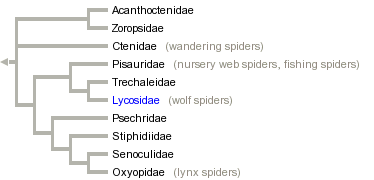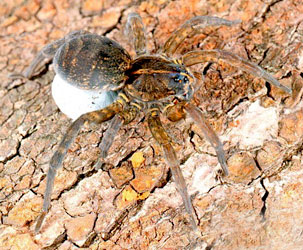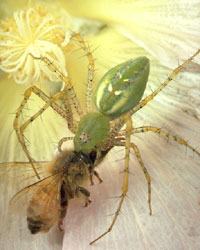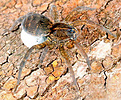Lycosoidea



This tree diagram shows the relationships between several groups of organisms.
The root of the current tree connects the organisms featured in this tree to their containing group and the rest of the Tree of Life. The basal branching point in the tree represents the ancestor of the other groups in the tree. This ancestor diversified over time into several descendent subgroups, which are represented as internal nodes and terminal taxa to the right.

You can click on the root to travel down the Tree of Life all the way to the root of all Life, and you can click on the names of descendent subgroups to travel up the Tree of Life all the way to individual species.
For more information on ToL tree formatting, please see Interpreting the Tree or Classification. To learn more about phylogenetic trees, please visit our Phylogenetic Biology pages.
close boxReferences
Bosselaers, J. 2002. A cladistic analysis of Zoropsidae (Araneae), with the description of a new genus. Belgian Journal of Zoology 132:141-154.
Coddington, J. A. and H. W. Levi. 1991. Systematics and evolution of spiders (Araneae). Annual Review of Ecology and Systematics 22:565-592.
Fang, K., C. C. Yang, B. W. Lue, S. H. Chen, and K. Y. Lue. 2000. Phylogenetic corroboration of superfamily Lycosoidae spiders (Araneae) as inferred from partial mitochondrial 12S and 16S ribosomal DNA sequences. Zoological Studies 39:107-113.
Sierwald, P. 1997. Phylogenetic analysis of pisaurine nursery web spiders, with revisions of Tetragonophthalma and perenethis (Araneae, Lycosoidea, Pisauridae). Journal of Arachnology 25:361-407.
Townsend, V. R. and B. E. Felgenhauer. 2001. Phylogenetic significance of the morphology of the cuticular scales of the lynx spiders (Araneae : Oxyopidae). Journal of Zoology 253:309-332.
Title Illustrations
| Scientific Name | Lycosa (Hogna) helluo |
|---|---|
| Comments | Wolf spider female with egg sac. |
| Specimen Condition | Live Specimen |
| Sex | Female |
| Life Cycle Stage | adult, egg sac |
| Copyright | © Jim Kalisch |
| Scientific Name | Oxyopidae |
|---|---|
| Comments | Lynx spider with captured bee. |
| Creator | Photograph by Alden M. Johnson |
| Acknowledgements | courtesy CalPhotos |
| Specimen Condition | Live Specimen |
| Behavior | predation |
| Copyright | © 2001 |









